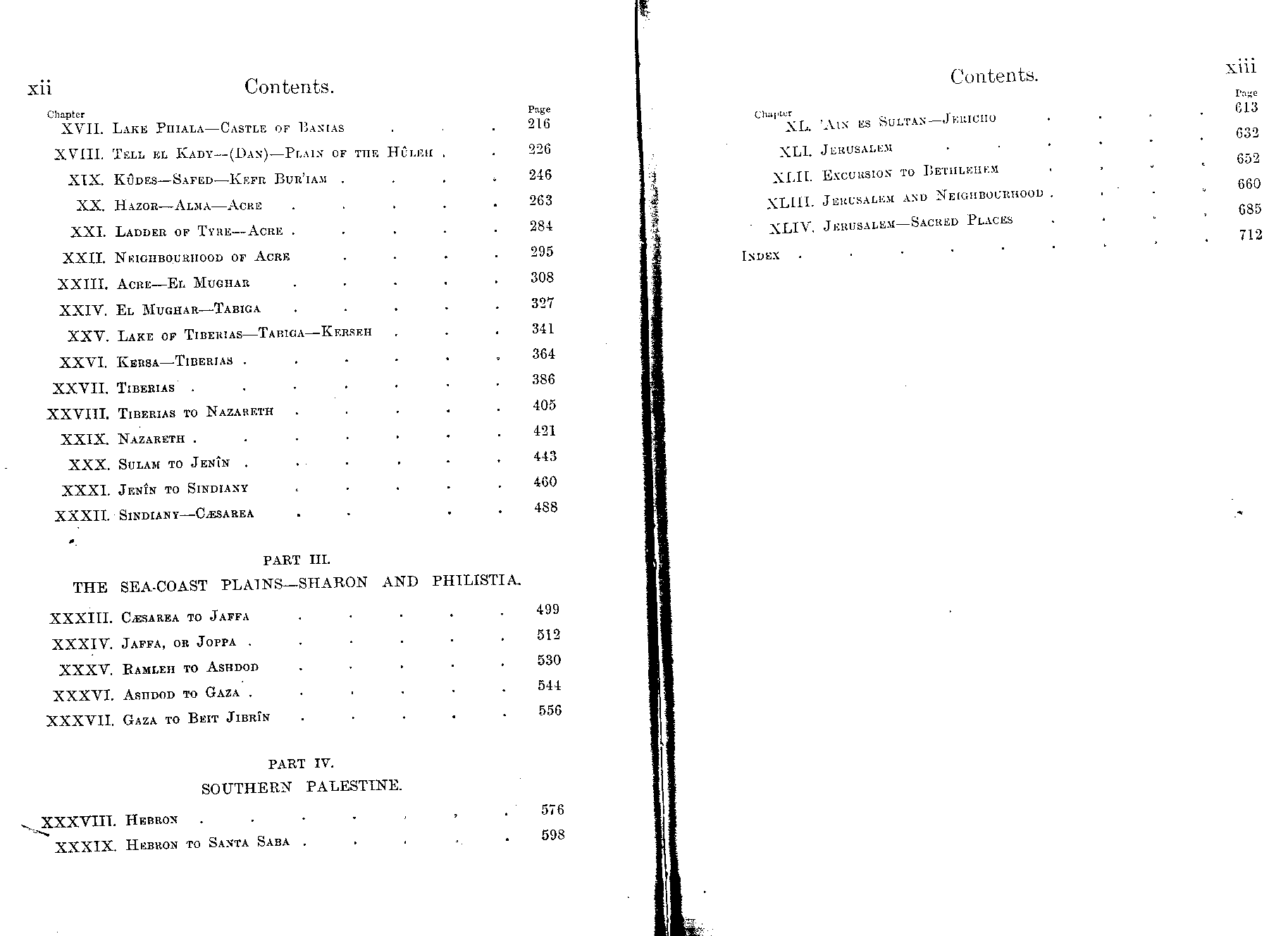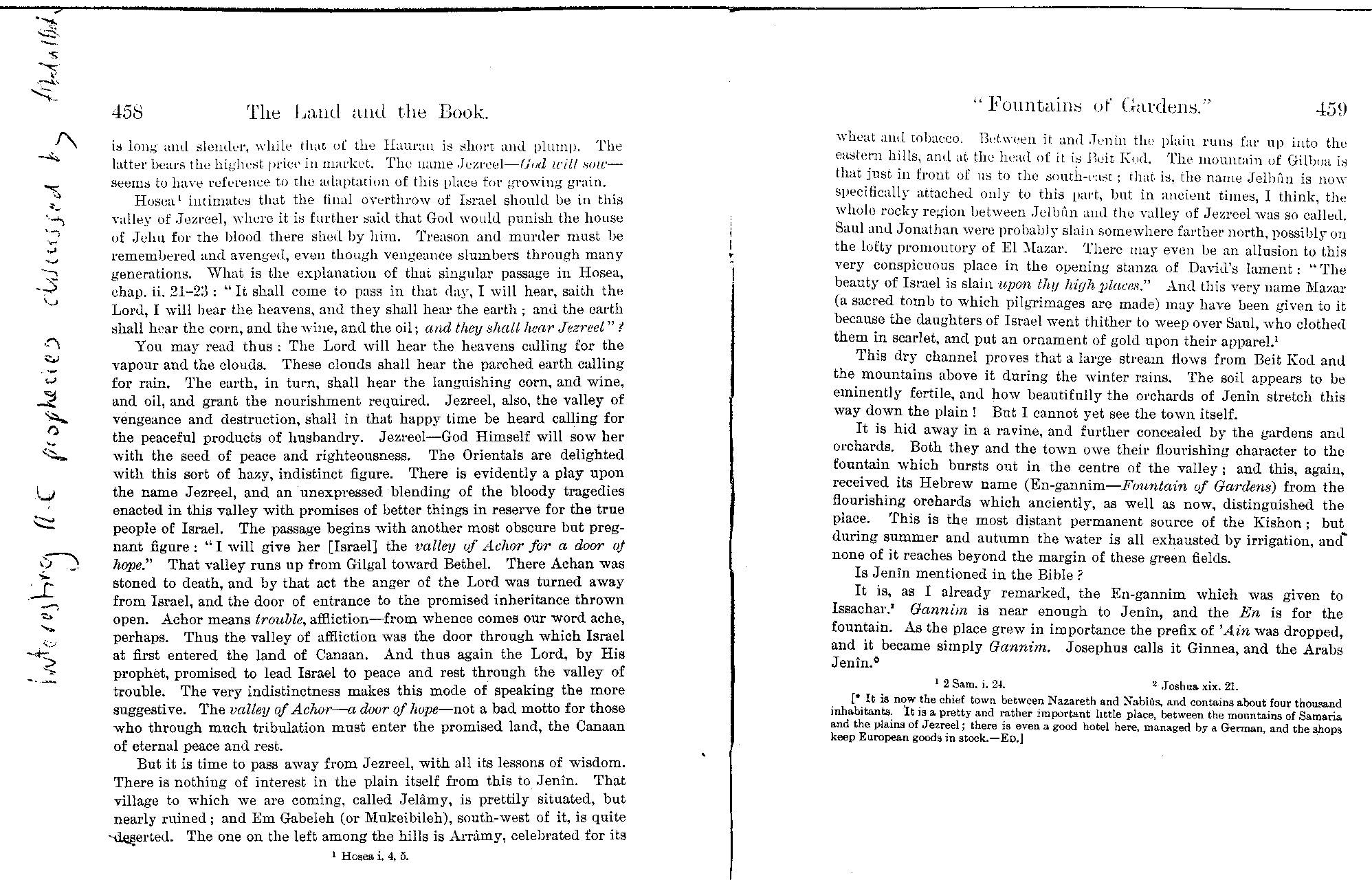
|
|
Abstract: Description of the area around Akka in 1857. Does not mention the Faith. |
The Land and Its Book:
Biblical Illustrations drawn from the Manners and Customs, the Scenes and Scenery of the Holy Land
by W. M. Thomson
pages 458-459London: Thomas Nelson and Sons, 1910
1. Text
[page x]
Introduction.
"RAS BEIRUT, January 20, 1857.
"MY DEAR W--, I this morning woke to final life's long dream a beautiful
reality. For twenty years and more, as you well know, a visit to Palestine has
been the unattained object of my fondest aspirations; and now here am I safely
landed on her sacred shore, in perfect health, and ready to prosecute our
pilgrimage with cheerful courage and high hope. The compact of our boyhood is
to be realized, and I summon you to fulfill your part of it. This land of the
Bible must become familiar to me as childhood's home. There are lessons in
everything around me, I feel quite sure, and teachers on every side, did I but
know their language. You are to be my dragoman to interpret this unknown tongue
of the Holy Land. Such, you remember, is our compact.
"I am told that the necessary preparation for our travels can only be made in
this city. Come on, therefore, without delay, and let us gather together
whatever will contribute to our comfort, safety, and success. This will reach
you by messenger express. The answer, I hope, will be yourself."
This summons was neither unexpected nor reluctantly obeyed; and a few hours'
ride along the shore brought the author from Simon to Beirut, where the
long-separated met in the hospitable mansion of a mutual friend. And now, kind
reader, I trust that, like ourselves, you are eager to commence this tour of
the Holy Land. But we must begin our preparations for it with "the garment of
patience." Horses, and mules, and tents, and canteens, and beds, cooking
apparatus, and servants to use it, with many other things too trifling to be
mentioned, yet too necessary to be omitted, cannot be secured in a day.
Meanwhile we may employ some of the hours of unavoidable delay in excursions to
sites and scenes in and around our beautiful city. indeed, we invite you to
join us in such a ramble at once through these charming suburbs.
[page 458]
"Fountains of Gardens."
is long and slender, while that of the Hauran is short and plump. The
latter bears the highest price in market. The name Jezreel--God will
sow--seems to have reference to the adaptation of this place for growing
grain.
Hosea1 intimates that the final overthrow of Israel should be in
this valley of Jezreel, where it is further said that God would punish the
house of Jehu for the blood there shed by him. Treason and murder must be
remembered and avenged, even though vengeance slumbers through many
generations. What is the explanation. of that singular passage in Hosea, chap.
ii. 21-23: "It shall come to pass in that day, I will hear, saith the Lord, I
will hear the heavens, and they shall hear the earth; and the earth shall hear
the corn, and the wine, and the oil; and they shall hear Jezreel"?
You may read thus: The Lord will hear the heavens calling for the vapour and
the clouds. These clouds shall hear the parched earth calling for rain. The
earth, in turn, shall hear the languishing corn, and wine, and oil, and grant
the nourishment required. Jezreel, also, the valley of vengeance and
destruction, shall in that happy time be heard calling for the peaceful
products of husbandry. Jezreel--God Himself will sow her with the seed of peace
and righteousness. The Orientals are delighted with this sort of hazy,
indistinct figure. There is evidently a play upon the name Jezreel, and an
unexpressed blending of the bloody tragedies enacted in this valley with
promises of better things in reserve for the true people of Israel. The passage
begins with another most obscure but pregnant figure: "I will give her [Israel]
the valley of Achor for a door of hope." That valley runs up from Gilgal
toward Bethel. There Achan was stoned to death, and by that act the anger of
the Lord was turned away from Israel, and the door of entrance to the promised
inheritance thrown open. Achor means trouble, affliction--from whence
comes our word ache, perhaps. Thus the valley of affliction was the door
through which Israel at first entered the land of Canaan. And thus again the
Lord, by His prophet, promised to lead Israel to peace and rest through the
valley of trouble. The very indistinctness makes this mode of speaking the more
suggestive. The valley of Achor--a door of hope--not a bad motto for
those who through much tribulation must enter the promised land, the Canaan of
eternal peace and rest.
But it is time to pass away from Jezreel, with all its lessons of wisdom. There
is nothing of interest in the plain itself from this to Jenin. That village to
which we are coming, called Jelamy, is prettily situated, but nearly ruined;
and Em Gabeleh (or Mukeibileh), south-west of it, is quite deserted. The one on
the left among the hills is Arramy, celebrated for its
-
1 Hosea i. 4, 5.
[page 459]
wheat and tobacco. Between it and Jenin the plain runs far up into the
eastern hills, and at the head of it is Beit Kod. The mountain of Gilboa is
that just in front of us to the south-east; that is, the name Jelbun is now
specifically attached only to this part, but in ancient times, I think, the
whole rocky region between Jelbun and the valley of Jezreel was so called. Saul
and Jonathan were probably slain somewhere farther north, possibly on the lofty
promontory of El Mazar. There may even be an allusion to this very conspicuous
place in the opening stanza of David's lament: "The beauty of Israel is slain
upon thy high places." And this very name Mazar (a sacred tomb to which
pilgrimages are made) may have been given to it because the daughters of Israel
went thither to weep over Saul, who clothed them in scarlet, and put an
ornament of gold upon their apparel.1
This dry channel proves that a large stream flows from Beit Kod and the
mountains above it during the winter rains. The soil appears to be eminently
fertile, and how beautifully the orchards of Jenin stretch this way down the
plain! But I cannot yet see the town itself.
It is hid away in a ravine, and further concealed by the gardens and orchards.
Both they and the town owe their flourishing character to the fountain which
bursts out in the centre of the valley; and this, again, received its Hebrew
name (En-gannim--Fountain of Gardens) from the flourishing orchards
which anciently, as well as now, distinguished the place. This is the most
distant permanent source of the Kishon; but during summer and autumn the water
is all exhausted by irrigation, and none of it reaches beyond the margin of
these green fields.
Is Jenin mentioned in the Bible?
It is, as I already remarked, the En-gannim which was given to
Isaachar.2 Gannim is near enough to Jenin, and the
En is for the fountain. As the place grew in importance the pre6x of
'Ain was dropped, and it became simply Gannim. Josephus calls it
Ginnea, and the Arabs Jenin.*
-
1 Sam. i. 24.
2 Joshua xix. 21.
["It is now the chief town between Nazareth and Nablus and contains about four thousand inhabitants. It is a pretty and rather important little place, between the mountains of Samaria and the plains of Jezreel; there is even a good hotel here, managed by a German, and the shops keep European goods in stock. -- Ed.]
2. Image scans (click image for larger version)

|
|

